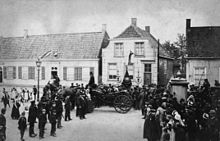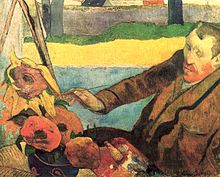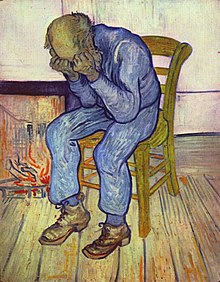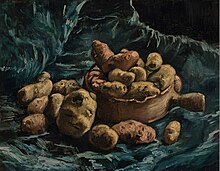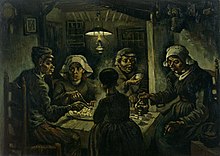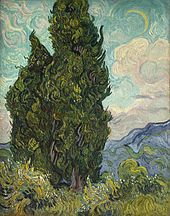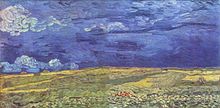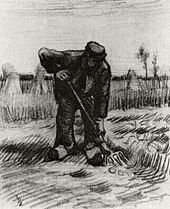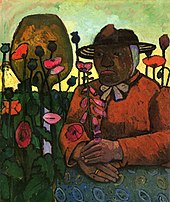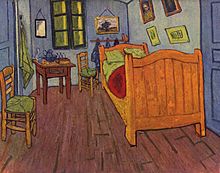Vincent van Gogh
Vincent Willem van Gogh [ ɡɔx , Dutch ɣɔx ] (born March 30, 1853 in Groot-Zundert , † July 29, 1890 in Auvers-sur-Oise ) was a Dutch painter and draftsman. He is considered one of the founders of modern painting . According to the current state of knowledge, he left 864 paintings and over 1000 drawings, all of which were created in the last ten years of his life. Vincent van Gogh conducted an extensive correspondence, which contains a wealth of references to his painterly work and is itself of literary rank.
His main work, which is stylistically assigned to post-impressionism , exerted a strong influence on subsequent artists, especially the Fauves and the Expressionists . While he was only able to sell a few paintings during his lifetime, his works have achieved record prices at auctions since the 1980s .
Life
childhood
Vincent van Gogh was born on March 30, 1853 in Groot-Zundert, a small country town in Noord-Brabant , as the son of pastor Theodorus van Gogh and his wife Anna Cornelia, the daughter of a bookbinder. Exactly a year earlier, a non-viable brother had been born, also named Vincent. Some authors are of the opinion that van Gogh felt himself to be an unloved substitute for the firstborn and suffered psychological damage as a result. He should never forget the early impressions of his rural home; many of his pictures testify to his love for nature. Five younger siblings were born after Vincent: Anna (1855–1930), Theo (1857–1891), Elisabeth 'Lies' (1859–1936), Willemien 'Wil' (1862–1941) and Cor (1867–1900). The father was a pastor of the Dutch Reformed Church ; Christian values played an important role in the family. But there were also links to the art trade , where three of Vincent's uncles worked.
The child, later described as solitary , first attended the village school in Zundert. At the age of eleven and a half he was sent to a boarding school in Zevenbergen . From 1866 Vincent attended secondary school in Tilburg , where he again lived away from his family. There he learned French, English and German (later he read French and English books in the original language and corresponded with his siblings in French), and four hours of drawing were scheduled each week. His drawing teacher was the painter Constant Cornelis Huijsmans (1810–1886). Despite good grades, he left this school in March 1868 for an unknown reason. He spent the next 15 months with his parents; what he did there is not documented. In July 1869, following a decision by the family council, he began training in the Hague branch of the art dealer Goupil & Cie, to which his uncle Cent was a partner.
Job search: salesman, teacher, preacher, painter
Goupil was a major company with offices in several capital cities. Vincent van Gogh got to know and judge established art there. Here, as at his later locations, he eagerly visited the local museums. After completing his training, he was transferred to the London branch in the summer of 1873 , where Goupil only had one warehouse. Far from his relatives, Vincent van Gogh felt lonely. In his spare time he made long walks through the city and its surroundings, including making drawings. During this time an unhappy love for the daughter of his landlady fell. Years later, he had not got over his disappointment at the young woman's rejection. During a vacation with his parents in the summer of 1874, they noticed his dejection. In order to free him from the London conditions, it was decided to have him transferred to Paris . From January to April 1875, van Gogh lived in London again for a short time before finally moving to Paris.
There he isolated himself more and more and showed unusual behavior on duty. He turned more and more to religion; he only read the Bible and books of edification. After he had gone home for Christmas 1875 - apparently illegally - his superior suggested that he be resigned in April 1876, which Van Gogh then announced. The main reason for the termination seems to have been his problems dealing with customers; Vincent van Gogh, who abhorred hypocrisy, was extremely unsuitable as a seller.
During the following three and a half years he tried unsuccessfully in various professions. After working briefly as an assistant teacher at a school in Ramsgate ( Kent ) he transferred to another school in Isleworth (now London), by a Methodist minister was headed. Here he had the opportunity to work as an assistant pastor. He spent Christmas 1876 with his parents, who had meanwhile moved to Etten ; at their insistence he did not return to England. This was followed by a short internship in a bookstore, which van Gogh broke off because he had now decided to study theology. He moved to live with an uncle in Amsterdam, where he took private classes in Latin, Greek and mathematics in preparation for the university entrance exam. After almost a year, however, he gave up teaching again, because "[...] I consider the whole university, at least the theological one, to be an indescribable hoax where sheer Phariseeism is cultivated." Instead, he attended a seminar for lay preachers in August 1878 Brussels, but was classified as unsuitable after the three-month probationary period, probably because he was unable to subordinate himself to class.
Nevertheless, he found a trial job as an assistant preacher in the Borinage near Mons , a Belgian coal mining area, where people lived under particularly harsh conditions. There he identified himself to a large extent with the fate of the miners. He gave away clothes, neglected his appearance and lived in poor conditions. This was not what his superiors wanted, and in July 1879, van Gogh learned that his position would not be extended. This twofold rejection on the part of the church is probably one reason why he completely turned away from Christianity in the period that followed. He stayed at the Borinage for another year, drew a lot and now thought of taking up an artistic profession. In the fall of 1880, at the age of 27, he decided to become a painter.
Vincent and Theo van Gogh
Vincent van Gogh's brother Theo , who was four years his junior, began to provide for a living from mid-1880 . Theo had also joined Goupil and was now running a Parisian branch of the art dealer. According to an agreement, he received a large part of Vincent's paintings in return, which Vincent regularly sent him to Paris. Although the support was by no means small, Vincent van Gogh lived from now on in constant financial need. Apparently he couldn't handle money; Contemporaries also report that he generously gave gifts to those in need.
Theo was also his confidante, his most important reference person and his - albeit less successful - art dealer. The extensive correspondence that the brothers conducted from 1872 is an important source of Van Gogh research.
In a letter to his future wife in 1889, Theo van Gogh characterized his brother: “As you know, he has long broken with everything that is called convention. His way of dressing and his allure show immediately that he is a special person, and for years anyone who sees him has been saying: 'This is a madman.' [...] There is already something in his way of speaking, for the sake of which one either thinks a lot of him or cannot stand him. [...] It is not possible for him to associate with someone in an indifferent way. "
Start as a painter
Vincent van Gogh's early work hardly shows that he would one day become an important painter. He wanted to learn the basics and was suitable self-taught on, drew upon textbooks and copied from him admired drawings and prints. In order to come into contact with art and artists, he moved to Brussels in October 1880 , where he continued his self-study. There is no clear evidence that, as occasionally noted, he ever attended the art academy there (although he was enrolled). In Brussels he met Anthon van Rappard , with whom he exchanged ideas about artistic questions, who taught him, visited him several times in the following years and with whom he was in contact for a long time. After Rappard had left Brussels, van Gogh returned to his parents' house in Etten in April 1881 (probably also for economic reasons).
There he drew again - in addition to landscape motifs of the area - mainly farm work and workers. During the summer he fell in love with his cousin Kee Voss, who had come to visit. Despite his negative answer, van Gogh persisted in his recruiting, which led to a confrontation with parents and relatives. Da Vincent's relationship with the family was strained anyway - he was considered a failure - a dispute arose which ended shortly after Christmas 1881 with his departure.

Van Gogh had already spent four weeks in November / December 1881 with his cousin Anton Mauve in The Hague, whose work he held in high esteem and who had introduced him to watercolor and oil painting . After being kicked out of his parents' house, van Gogh moved to The Hague and continued teaching with Mauve, but only for a few weeks - in addition to artistic differences of opinion, van Gogh's socially unacceptable liaison with his model Sien , the occasional prostitute Clasina Hoornik, was an essential one Reason for separation from his teacher. This relationship had also increased the pressure from the family (not even Theo supported him in this regard, nor could he finance the maintenance of an entire family, Sien had a four-year-old daughter and gave birth to son Willem in 1882, and living together was therefore soon difficult) . In the autumn of 1883, Van Gogh separated from Sien, fully aware that he would forego having a family of his own for the future: "We are now faced with this fact - my firm resolution to be dead for everything except my work." At the time, van Gogh limited himself to easy-going women or women who could be bought for a small amount.
After separating from Sien, in September he moved to the northern Dutch province of Drenthe , a heather and moor landscape that was valued by artists such as Max Liebermann for its picturesque atmosphere . In December he returned to his parents, now living in Nuenen , who took him in rather half-heartedly. After his father died on March 26, 1885, van Gogh moved to his studio nearby.
During the two years that the painter spent in Nuenen, he created over 180 paintings, mainly pictures of farmers from the area, but also numerous still lifes. From the end of 1884 he had four amateurs from nearby Eindhoven as pupils who, however, paid him not with money but with meals and colors. In 1885 he created the painting The Potato Eaters , which is considered the main work of this period. However, the artist suffered from his isolation in the provinces. The art city closest to him was Antwerp , where he set out in November 1885.
Antwerp and Paris
Vincent van Gogh was to stay in Antwerp for three months. Soon there was a shortage of money. The painter would rather save on food than on painting materials; in his letters he complained of health problems and weakness as a result of the poor diet. Mainly because models and heated rooms were available there free of charge, the now 32-year-old attended courses at the art academy. Reports from former fellow students have come down to us, which in turn describe him as an eccentric and an outsider. When the holidays at the academy began in March 1886, van Gogh went to see his brother Theo in Paris , the center of the art world at the time.
Theo took his brother into his apartment with some hesitation. In fact, the two-year coexistence of the two should be marked by ups and downs.
Van Gogh took courses for a few months in Fernand Cormon's studio , a private art school. It was here in particular that he made the acquaintance of numerous other painters, including Henri de Toulouse-Lautrec , Paul Signac , Louis Anquetin and Paul Gauguin . He became friends with Émile Bernard . He was evidently well integrated in the group of young colleagues who, like him, were still waiting for the breakthrough. Van Gogh, who advocated a merger of the competing and often divided artists, organized two joint exhibitions in restaurants, which, however, remained unsuccessful for him. The exhibition of pictures in the window of the paint dealer and art lover Père Tanguy was also unsuccessful .
In Paris, van Gogh got to know the then current art style, impressionism . Under this impression, his previously dark palette lightened and he began to experiment with different painting techniques. He painted a lot outdoors, especially in the rural areas of Paris, such as Montmartre and Asnières. At the same time he got to know ukiyo-e - Japanese woodblock prints, for example by Katsushika Hokusai - and began to collect them. In 1887 he organized an exhibition of ukiyo-e woodcuts in Cafe Le Tambourin , with whose owner Agostina Segatori he briefly had a love affair.
In the long run, however, the hectic city life and the frequent quarrels among the painters, including the fact that he had been banned from painting on the street, were unbearable for him. He decided to leave the city, about which he later wrote to Theo: "[...] when I drove away from you at the Gare du Midi, I was heartbroken and almost sick and almost a drunkard because I had broken myself so badly." In February 1888 he traveled to Arles in the south of France .
Arles
Van Gogh chose the south of France for several reasons. On the one hand, he wanted to avoid the northern winter, on the other hand, he hoped to find the “blue tones and cheerful colors” of the south here. Originally, Arles was only intended as a stopover on the way to Marseille , where he wanted to work as an art dealer for Theo; however, this plan was not carried out.
Van Gogh initially lived in a pension. In April he rented a studio in the Yellow House , where he also lived from September.
From an artistic point of view, the stay in Arles was particularly productive; in sixteen months van Gogh created 187 paintings. In the absence of models, he first turned to the landscape. After the Langlois bridge, he painted a series of flowering orchards and other motifs from the area around Arles in spring. In May, van Gogh went on a multi-day trip to Saintes-Maries-de-la-Mer , from where he brought home, among other things, the sketches for the later painting Fishing Boats on the Beach at Les Saintes-Maries .
After a while, van Gogh began to make acquaintances, including various painters who temporarily lived in the area. He showed great sympathy for Eugène Boch , whom he portrayed. Contacts developed with fellow citizens of Arles, which were reflected in portraits. The friendship with the postmaster Joseph Roulin was of particular importance. Van Gogh painted all the members of the Roulin family of five several times, including the postmaster six times.
After his apartment was fully furnished in September, van Gogh was able to think of realizing a long-cherished dream: the studio of the south , where artists lived and worked together. Only Paul Gauguin, however, agreed to come after a long hesitation after Theo van Gogh had promised him that he would cover the travel expenses and monthly support. Van Gogh looked forward to Gauguin's arrival with both joy and tension. In order to impress his colleague and to decorate the room intended for him, he painted numerous pictures in a short time, including the well-known sunflower pictures . He also painted tirelessly in order to offer Theo, in whose debt he felt deeply, an equivalent for the continuous payments. Before Gauguin's arrival, van Gogh complained of health problems from exhaustion.
On October 23, Gauguin arrived in Arles; a little later, the relationship between the two difficult characters was strained by conflicts. The coexistence ended exactly two months later with an incident that was never fully resolved, in the course of which van Gogh is said to have cut off a large part of his left ear after an argument with Gauguin, as Paul Gauguin reported. However, this person can also be considered as a perpetrator. Van Gogh was found the next morning, unconscious and weak from blood loss. The arteria auricularis posterior was after Vincent's letter of 7./8. Severed January 1889, which resulted in considerable blood loss. Gauguin notified Theo and drove to Paris.
The incident is considered to be the first manifestation of a disease that was then, probably incorrectly, diagnosed as epilepsy . As the painter's popularity grew, doctors and psychologists posthumously - and without conclusive results - made a multitude of alternative diagnoses using pictures, letters, and notes. According to the patient, the seizures were associated with delusions , nightmares and depression . In the remaining year and a half of his life he got them several times for days or even weeks and they prevented him from painting. In the intermediate phases, however, he was clear and efficient.
He was treated in Arles hospital for about two weeks because of the blood loss; in February 1889, another attack made it necessary to stay in hospital for several days. As soon as he was released, he was detained in the hospital again because of a petition from citizens who feared his uncanny behavior. This forced internment was lifted in April. Since the painter did not yet trust himself to live alone - possibly also in order not to burden his brother, who had recently married, too much - he decided to move to the nearby Saint-Paul-de-Mausole mental hospital in Saint-Rémy-de-Provence .
Saint-Rémy

The privately run mental hospital in Saint-Rémy, where the painter arrived on May 8th, was housed in a former monastery from the 12th century. There was no treatment there; Vincent van Gogh wrote a letter complaining of the complete inactivity of his fellow patients, from whom he stayed away whenever possible.
However, he himself was allowed to paint as therapy and began to do so in the first few days after his arrival. The often failed, withdrawn man now clung to his work even more than before. First he painted motifs from the institution's garden and the view from his window, then motifs from the area around Saint-Rémy and the starry night that later became famous .
In the summer he had a severe seizure during which he (as well as during another seizure at the end of the year) tried to swallow poisonous paints, which could possibly be considered a suicide attempt. After that he did not dare leave the house for weeks, but painted several self-portraits. He also turned a number of paintings that he valued and owned as black and white reproductions - mainly by Delacroix and Millet - into color paintings. In the spring of 1890 he returned to the subject of the irises.

Between September 1889 and April 1890, Theo submitted paintings by van Gogh to three well-known exhibitions of avant-garde art. This was the first time the painter reached a broader public. The reactions were appreciative and culminated in an enthusiastic article in an art magazine. In addition, the painting The Red Vineyards by Arles van Goghs was sold at one of the exhibitions in early 1890 - it is the only documented sale from its mature period. The painter was more anxious than happy about the success that might now be on the horizon.
Van Gogh had been pursuing the intention of leaving the institution in which he felt himself a prisoner and moving back to the north since autumn. This raised the question of a place where he would receive the necessary care. In the spring of 1890 the question seemed resolved: in Auvers-sur-Oise , about 30 km from Paris, the art lover and doctor Paul Gachet would take care of him.
Last months
On May 17, 1890 Vincent van Gogh met his brother, his wife and their son, also named Vincent, who was born at the end of January in Paris. The atmosphere in the family was tense: Theo had differences with his employers and toyed with the idea of setting up his own gallery - a financial risk especially now that it was not only for the brother, but also for his wife and child had worries; in addition, he had been affected by various health disorders for some time. After just three days, Vincent van Gogh rushed to Auvers to see Dr. Gachet on.
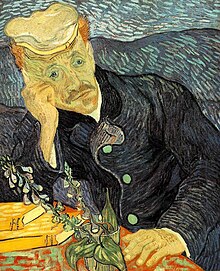

Person and conduct of Dr. Gachet, of whom his new patient said: "[...] his experience as a doctor must keep him in balance in the fight against the nervous disease from which he seems to me to suffer at least as seriously as I [...]", are in the Literature judged differently. If it is said on the one hand: "Vincent couldn't find a better therapist for his illness", more recent research considers him more of a hypocrite who misdiagnosed van Gogh's illness, exploited him by "ordering" picture gifts, and possibly ultimately killing him drove. The widower Gachet was known to numerous modern artists, including Paul Cézanne and Claude Monet , whose pictures he collected, and was an artist himself in his spare time. Van Gogh lived in the inn, but was invited to dinner once a week with the doctor, who was very impressed with his painting.
In Auvers the painter fell into a real creative frenzy. In 70 days he created around 80 paintings and 60 drawings. The still rural Auvers with its thatched huts offered him numerous motifs. He painted the houses of the village , his church and the portraits of some residents, including that of Dr. Gachet and his daughter . On July 6th, he visited his brother and his family in Paris, where, as in the previous time, there were apparently domestic disputes. The painter drove back the same evening, depressed. Among other things, he now painted the cornfields surrounding Auvers in a rainy mood.
On July 27th, van Gogh shot himself in the chest outdoors (according to another representation: in the stomach), but was able to return to the inn. There was a lot of speculation about the motives for the act: It is possible that now that Theo was a family father, he feared his undivided attention and also no longer wanted to burden his brother financially in the insecure professional situation; possibly death should also raise the price of his paintings in favor of Theos. Another possible motive is that an impending love affair with the 21-year-old daughter Gachets was forbidden by her father. In addition, it cannot be ruled out that the shot was a “ cry for help ” with no real intention to kill. According to a recent theory, van Gogh should not have died by suicide, but rather became the victim of an accident.
The two doctors called, including Dr. Gachet, refrained from removing the bullet. Vincent van Gogh died on July 29th in the presence of his brother. He is buried in the Auvers cemetery next to Theos, who outlived him by six months and died of complications from syphilis .
plant
Dutch period
Vincent van Gogh did not receive any significant lessons in painting. He developed his knowledge and skills autodidactically by studying pictures by older painters whom he admired and also copying some. In the years 1880–1885, which he spent in Holland and Brussels, respectively, it was two compatriots of the 17th century who exerted the greatest influence on his work: Rembrandt and Frans Hals . From them he took over the palette of brown, gray and black tones, the chiaroscuro painting, the impasto application of paint with the rather coarse, visible brushstrokes, the neglect of image details in favor of a more haunting overall effect. He expressly admired the way these old masters refrained from over-elaborating their pictures. “What particularly struck me when I saw the old Dutch pictures again is the fact that they are usually painted quickly. That the great masters - like a Hals, a Rembrandt, a Ruysdael and many others - sit down as much as possible de premier coup (with the first blow) and then don't do so much more, ”he wrote to his brother Theo in 1885. Van Gogh himself maintained this principle throughout his life.
In terms of content, he mainly worked on the topic that was most important to him - the world of ordinary people. During this “Dutch period” Van Gogh painted peasants at work, their poor huts, craftsmen, the potato is typically found in his still lifes. In doing so, he demanded of his pictures to be truthful and to convey a mood, a feeling or an idea - a demand that he also found fulfilled in his role models.
The most ambitious and best-known painting from this period is The Potato Eaters from 1885. It shows a peasant family having a simple meal; Van Gogh wanted to show the earthly connection and the hard life of the rural population. He tried very hard with this picture; Since he had difficulty grouping the people portrayed in a believable scene, he rented models and made many studies despite his tight budget. After the potato eaters, van Gogh never painted a multi-figure composition, nor did he put so much effort into a single picture.
Time of development: Antwerp and Paris
Vincent van Gogh was exposed to a variety of new impressions during his three-month stay in Antwerp, but above all in the two Parisian years 1886–1888. A phase of experimentation began for his own work, which ultimately led to a fundamental change in his painting style.
In Paris he encountered the then current art style, Impressionism , which until then he had only known by name. Even though he had reservations about the new style (the dissolution of the forms and the light application of paint contradicted his own goals too strongly, and he also missed content-related statements), van Gogh nevertheless adopted elements of impressionism in his own painting. He now used lighter, pure colors and switched to dashed, comma-shaped brush strokes or points (this was a suggestion from pointillism ), where he liked to put together colored areas from complementary colored elements. The encounter with paintings by Eugène Delacroix supported the turn to a stronger color. Thematically, he turned to Parisian motifs, and he often painted in the rural surroundings of the city. Examples of Impressionistically influenced pictures from this period are fishing in spring, Pont de Clichy (1887), bridges over the Seine near Asnières (1887) or vegetable gardens on Montmartre (1887).

Most important for his artistic development, however, was the encounter with the Japanese woodblock print . Japan opened its borders in 1853, and more and more leaves found their way to Europe in the years that followed. Many artists were enthusiastic about the completely new art of Japonism , and Van Gogh was also fascinated. He put on a collection of colored woodcuts and also transferred some motifs in oil paintings, such as the portrait of Père Tanguy . Above all, however, he learned from the Japanese conception of art and made its design principles his own. Practically every picture he painted from now on shows one or the other “Japanese” design element: the lack of body and cast shadows , “flat” areas of color that are bordered with thin lines, unusual perspectives, tiny people depicted in a landscape (for Example of road works in Saint-Rémy , 1889). He wrote to Theo about his painting The Artist's Bedroom : "Shadows and cast shadows have been left out, and the colors are flat and simply applied like in Japanese prints [...]" . His choice of motifs is also partly influenced by Japanese, for example in the series of flowering fruit trees from spring 1888.
Mature style: Arles
In Arles Vincent van Gogh began to paint in the new style that he had theoretically developed in the last few days in Paris, but had not yet consistently applied. This style of painting, which he essentially retained until his death, is the one that we consider “typical” for van Gogh today.
Colours

Vincent van Gogh moved to Arles in the hope of the bright colors of the south: "[...] because there [...] the beautiful contrasts of red and green, blue and orange, sulfur yellow and purple are naturally found." In fact, soon after his arrival there, he was painting with pure, bold colors, which he liked to place next to each other in complementary contrasts so that they enhanced each other's effect. In doing so, he ignored the local colors , i.e. the natural colors of the objects. Often he exaggerated the colors or used them to match the color scheme he had developed for the particular image. At Van Gogh there are green skies, pink clouds, turquoise streets. He himself wrote: “I take from nature a certain sequence and a certain accuracy in the placement of tones, I study nature so that I don't make nonsense and remain reasonable; but whether my color is literally exactly the same doesn't really matter to me if it only works well in my picture [...]. ” Despite the bright colors and strong contrasts, van Gogh's pictures never seem garish or striking. He ensured a harmonious harmony by also using intermediate tones that soften and connect the other colors.
For van Gogh, color also had a symbolic function. Colors should express moods, as in the picture Das Nachtcafé (1888): “I tried to express the terrible human passions with red and green. The room is blood red and dull yellow, a green billiard table in the middle, four lemon yellow lamps with orange and green circles of rays. Everywhere there is struggle and antithesis [...] "
Painting style

Vincent van Gogh painted quickly, spontaneously and without making major corrections afterwards. On the one hand, the swift painting style met his creative urge, but on the other hand he also used it very deliberately as a means of expression: It was intended to give his pictures more liveliness, intensity and immediacy. He also simplified the motifs in favor of a greater overall effect. Even if he painted quickly, he still didn't paint impulsively or even ecstatically; prior to execution, he prepared his paintings mentally, sometimes in several drawings.
He almost always painted “in front of the motif”, only in very rare cases from memory or imagination. Even if he often strongly reshaped what he saw, he always remained committed to reality and never crossed the border to abstraction.
Van Gogh used to apply the colors impasto, i.e. undiluted or only slightly diluted, and sometimes pressed them directly from the tube onto the canvas. The thick application of paint makes his brushstrokes vividly visible and is therefore ideally suited to bring out van Gogh's special brushwork. In addition to the "Japanese" style of smooth colored surfaces surrounded by contours, he had already developed a technique in Paris to place the colors next to one another in small lines ( meadow with flowers under a stormy sky , 1888/1889, flowering orchard with a view of Arles , 1889) . In order to make his paintings even more lively and moving, he began in Saint-Rémy to rhythmise these lines and arrange them in wavy lines, circles or spirals, for example in the self-portrait , 1889/90, or in the Starry Night , 1889. The respective painting style was chosen van Gogh depending on the motif (for example, he used the wave technique to depict cypresses).
There are several versions of many motifs; for example, van Gogh created seven versions of the famous sunflowers (one was destroyed in World War II). He did this on the one hand to try out variations or to make improvements, on the other hand he often repainted pictures for himself or his brother that he wanted to give away or had given away.
Expression and symbolism
The mere reproduction of visible reality was not Vincent van Gogh's goal. Rather, it was more important to him to express the essence and characteristic of his motifs and the feelings he felt towards them. For example, he said of Eugène Boch's portrait: “I want to put the admiration and love I feel for him in the picture. [...] Behind the head [...] I paint the infinite, I make a simple background of the deepest, most haunting blue I can create, and through this simple combination the blonde, shining head gets something mysterious like that on the deep blue background Star in the deep blue sky. ” And about his later landscapes from Auvers he wrote: “ There are endless cornfields under cloudy skies, and I have not shied away from the attempt to express sadness and utter loneliness [...] ” The desired urgency of the expression achieved Painter, changing both shapes and colors; while he tended to simplify form, he exaggerated color.
In addition, van Gogh expressed himself through a variety of symbols. In many pictures he symbolically represented what he could not say in words. In addition to traditional symbols (for example the burning candle as a symbol of vitality, the extinguished candle as that of death), he primarily used an individual symbolic language, the meaning of which can only be understood through knowledge of his biography and his world of thoughts and feelings. In his still life with a drawing board, pipe, onions and sealing wax , created in 1889 after his first stay in hospital, he arranged the items that are now helpful to him: a health guide and the onions recommended by him against insomnia, the beloved pipe and the tobacco pouch, a letter by Theo as well as sealing wax as a symbol of the solidarity with friends, the burning candle as a sign that the fire of life has not yet gone out, the empty wine bottle as a symbol of turning away from alcohol consumption. The painting Walk in the Moonlight (1890) shows a couple walking through a landscape of olive groves and cypresses at the moon rise, the male figure being identified as the painter himself by red hair and beard. The picture is both an expression of van Gogh's desire for “real” life with a woman and a substitute for it: nature and the art that expresses it.
Van Gogh as a draftsman
With the attention paid to Vincent van Gogh's paintings, it is easy to forget that he was also a good and very productive draftsman. The drawing was at the beginning of his career as an artist, and it accompanied him until the end of his life. For a few weeks in the summer of 1888, he only made drawings in order to save on the expensive oil paints.
Van Gogh believed that in order to become a good painter, he first had to master drawing. That is why he began in 1880 to systematically acquire the laws of visual representation, for example the perspective and the proportions of the human body, using textbooks - in the absence of a teacher. In the Dutch years he mainly depicted simple, rural people as well as landscapes, including views of his temporary home in The Hague. He drew in mostly large formats with pencil or pen, sometimes with chalk or charcoal. After Anton Mauve had instructed him in the technique of watercolor painting at the end of 1881, he also made sheets colored with opaque paints . In Paris, drawing initially took a back seat to painting. It was not until 1887 that van Gogh began to draw more and more, including colored cityscapes of Paris.
In Arles he learned to appreciate the reed feather as a tool , which he cut from the reeds growing there. At the same time, he developed a new representation technique: the motif is reproduced in very varied lines, dots, curves and spirals using a pencil sketch using a bourdon tube. Many of his drawings from this period are related to paintings. Either the drawing served to prepare the painting, [...] then again he made a drawing of a painted motif afterwards. The latter should either give a third party an impression of the picture or help him to correct certain errors that he saw in the painted version [...]. Colored brush drawings depicting the houses and gardens of Auvers also date from the last weeks of Van Gogh's life.
Self-portraits
reception
Influence on modernity
When Vincent van Gogh died in 1890, he had already made a name for himself in circles of the artistic avant-garde. In the last year of his life, his pictures were shown at three exhibitions. Camille Pissarro and Claude Monet had expressed their appreciation for him, and a lengthy article had appeared in the literary magazine Mercure de France in 1890. At the beginning of the 20th century, his art had become so popular that large commemorative exhibitions were held, for example in Berlin and Paris in 1901, in Paris in 1905 and in Amsterdam, and in Cologne in 1912.
In the exhibition Manet and the Post-Impressionists at the end of 1910 / beginning of 1911, which Roger Fry had organized in the Grafton Galleries in London, van Gogh was the only Dutchman to be represented with 25 works alongside French artists such as Cézanne and Gauguin . This exhibition coined the art concept of Post-Impressionism and was supposed to represent painting of Impressionism as superseded.
With the growing presence of van Gogh's works, the number of artists increased, who received important impulses for their own work. Henri Matisse and the Fauves around him were among the first to pay attention to his work . Matisse got to know paintings by the Dutchman probably as early as the mid-1890s; they inspired him to increase expression through intense colors. Van Gogh had a great influence on the German Expressionists of the Brücke and the Blue Rider . The German painter Paula Modersohn-Becker got to know his pictures on one of her trips to Paris at the beginning of the 20th century. "She was also very taken with Van Gogh (e.g. the great Arlesian woman, La Berceuse, the sunflower still life, etc.)" , reported her husband . Other well-known painters who were under the impression of Van Gogh at the beginning of the 20th century are Edvard Munch , Pablo Picasso , Egon Schiele and Chaim Soutine . In the 1950s, Francis Bacon painted a number of new creations of Van Gogh's pictures, which are not only thematically bound to their model, but also in the painting style.
Myth and Media
In 1914 Theo's widow, Johanna van Gogh-Bonger , published the brothers' correspondence. This gave the public more information about the painter's living conditions. His moving fate, his early, tragic death and, in contrast, the steadily rising prices of his pictures made him the epitome of the “misunderstood genius” and offered welcome material for numerous adaptations in fiction, film and music. The exaggerations, one-sided interpretations and falsifications made in the process favored a “Van Gogh myth”, which still influences the way people see the painter today.
It started with the art historian Julius Meier-Graefe , who had already published a number of scientific writings on Vincent van Gogh when he published his novel about a seeker in 1921 . The purpose of this book was expressly to “promote the creation of legends […]. Because nothing is more necessary to us than new symbols, legends of humanity from our loins. ”The most famous novel adaptation today is probably Irving Stone's Lust for Life (German: A life in passion ) from 1934. Vincente Minelli's 1956 film of the same name is based on this novel, one of the most important of the more than one hundred existing Van Gogh films. In the musical field, Don McLean's pop song Vincent from 1971 stands out, referring to van Gogh's starry night with the refrain "starry starry night" and stylizing the painter as a misunderstood sufferer who is too good for this world.
Today, according to opinion polls, Vincent van Gogh is the best-known and at the same time by far the most popular painter of all. His high popularity is reflected not only in a large number of publications, in record visits to Van Gogh exhibitions and the prices of his pictures, but also in the ubiquity of Van Gogh motifs in the form of art prints, posters, calendars and many other things Commodities.
Color changes
The changes in the colors used by van Gogh have preoccupied art research for some time, as some pictures nowadays show clear changes compared to the color effects intended by van Gogh. At the beginning of 2013 it became known that Van Gogh's favorite yellow, depending on the mixture of colors , had changed to browns and greens due to light irradiation in various pictures (including the banks of the Seine [1887, Van Gogh Museum ]). In addition to chemical processes within and between the color mixtures and the natural UV radiation of sunlight, museum lighting is assumed to be another main cause of this effect. Some researchers are already warning about certain LED lights.
In numerous letters van Gogh had always written about the color purple (violet) used in the three versions of his painting Bedroom in Arles . Today's view of the various paintings shows blue to light blue walls. In the spring of 2016, a team from the Art Institute of Chicago , where one of the pictures hangs, announced the likely reason for the different color descriptions after years of research: the colors faded through exposure to light and, in particular, the violet reacts to a blue. A laboratory worker had examined blue particles of paint from the Chicago picture and, after turning them over, discovered that their backs were still purple. Investigations on the other two versions of the painting (in the Van Gogh Museum, Amsterdam, and Musée d'Orsay , Paris) confirmed this result.
Art market
What paintings Vincent van Gogh sold during his lifetime can no longer be traced today. Contrary to popular belief that he only sold one work, there could well have been ten. So far, only the sale of the painting Roter Weinberg to the Belgian painter Anna Boch for the price of 400 francs at an exhibition in Brussels in 1890 has been documented.
Shortly after Van Gogh's death, his fame, sales and prices soared. The first buyers included painters and people from their environment. An early and important collector was Helene Kröller-Müller , who first bought a Van Gogh painting in 1909. The Kröller-Müller Museum in Otterlo later emerged from their collection and today, after the Van Gogh Museum in Amsterdam, has the second largest collection of Van Gogh paintings.
In 1910 Gustav Pauli bought the poppy field for the Kunsthalle Bremen for 30,000 gold marks ( equivalent to half a million euros in 2013 ), which sparked the Bremen artist dispute. In 1929 the Berlin National Gallery paid 240,000 Reichsmarks ( equivalent to one million euros in 2013 ) for a Van Gogh painting .
The price explosion on the international art market in the 1980s and 1990s particularly affected paintings by van Gogh. In April 1987, his painting Sunflowers was auctioned for the equivalent of $ 39.9 million. This amount exceeded the previous maximum price for a work of art ever auctioned (a painting by Manet ) and is considered to be the beginning of a new era in the art trade in terms of auction prices for top works of the late 19th and early 20th centuries. Van Gogh's irises were auctioned for $ 53.9 million in November 1987 and his portrait of Dr. Gachet for $ 82.5 million. These, too, were the highest auction prices ever achieved for a work of art. The Prize for Portrait of Dr. Gachet is the tallest for a Van Gogh painting to date, and it wasn't until 2004 that another work of art ( Boy with a pipe by Picasso ) surpassed this value .
Fakes
Vincent van Gogh's work has always been a productive field of activity for art forgers. In addition, paintings were erroneously assigned to the painter without any fraudulent intent. The debate about the authenticity of Van Gogh's pictures is becoming increasingly intense.
The first forgeries were made in the 1890s: at a Van Gogh exhibition in Paris in 1901, two paintings had to be sorted out as not authentic. Since counterfeiting was actually not worthwhile at the time because the prices were still low, it is likely that insiders were at work who foresaw future market developments. Art historians suspect the painter and Gauguin friend Émile Schuffenecker and the hobby painter Dr. Gachet and its surroundings.
In 1928 the Wacker scandal moved the art world. The 'erotic dancer' Otto Wacker offered a large number of Van Gogh pictures in Berlin, probably made by his father Hans Wacker . The scandal arose because the authenticity of these pictures had first been confirmed by experts.
33 Wacker forgeries were also included in Jacob-Baart de la Faille's catalog raisonné published in 1928 ; their authenticity had to be revoked later. The most recent edition of de la Faille's catalog, published in 1970 and still a standard work today, lists 913 oil paintings, which, however, do not always seem to withstand critical scrutiny. Van Gogh expert Jan Hulsker , author of another catalog raisonné, put question marks on 45 of the 2125 works listed by de la Faille. The uncertainty in the professional world reflects the difficulties in the assessment: This can often only be done according to stylistic criteria; privately owned works are also often inaccessible for review. To make matters worse, van Gogh tried out a wide variety of painting styles in his Paris period and later often made several versions of the same motif.
In September 2013, the painting was Sunset at Montmajour dating from 1888 - in 1890 or to the collection of Theo van Gogh was one, was sold in 1901 and for a long time in an attic in Norway was - according to the latest research methods declared genuine and the Van Gogh Museum issued .
At the beginning of the 21st century, van Gogh's painterly oeuvre was estimated at 864 pictures, a number that will probably be corrected in view of a whole series of controversial paintings.
Films (selection)
- 1948: Van Gogh (short film) - France, directed by Alain Resnais , with Claude Dauphin
- 1956: Vincent van Gogh - A Life in Passion ( Lust for Life ) - USA, director: Vincente Minnelli , with Kirk Douglas and Anthony Quinn
- 1969: Van Gogh (TV) - BRD, director: Thomas Fantl , with Herbert Fleischmann
- 1985: Visit to van Gogh - GDR, film adaptation, director: Horst Seemann , with Christian Grashof
- 1987: Vincent - Australia, directed by Paul Cox, with John Hurt
- 1988: Vincent van Gogh (TV) - Finland, director: Veli-Matti Saikkonen, with Timo Torikka
- 1990: Akira Kurosawa's Dreams ( Yume ). Japan / USA, director: Akira Kurosawa , chapter "Crows"
- 1990: Vincent and I ( Vincent et moi , children's film) - Canada / France, director: Michael Rubbo, with Tchéky Karyo and Jeanne Calment
- 1990: Vincent and Theo ( Vincent and Theo ) - USA, directed by Robert Altman with Tim Roth and Paul Rhys
- 1991: Van Gogh - France, directed by Maurice Pialat , with Jacques Dutronc
- 2005: The Eyes of Van Gogh - USA, directed by Alexander Barnett, with Alexander Barnett and Lee Godart
- 2010: Vincent van Gogh - Painting with words - Great Britain, Director: Andrew Hutton, Actor: Benedict Cumberbatch
- 2010: Doctor Who : Episode 5x10, Vincent and the Doctor ( Vincent and the Doctor ), directed by Richard Curtis , with Tony Curran and Matt Smith
- 2016: Wahn, Wut or Lust - Great Britain, documentary about van Gogh's ear, based on Bernadette Murphy
- 2017: Loving Vincent - Great Britain, animated feature film in the style of his pictures about his death
- 2018: Van Gogh - On the Threshold of Eternity ( At Eternity's Gate ) - Film biography of Julian Schnabel with William Dafoe
Drama (selection)
- 2015: Messer am Ohr (monologizing of the letters) by Ines Eck
Novels
- 1934: Irving Stone : Lust for Life ; dt. Vincent van Gogh - A life of passion . Rowohlt, Reinbek near Hamburg 1968, ISBN 978-3-499-11099-3 .
- 2013: JR Bechtle: Hotel van Gogh . Frankfurter Verlagsanstalt, Frankfurt 2013, ISBN 978-3-627-00190-2 .
- 2013: Jürgen Volk: Absolutely. Van Gogh and Gauguin in the yellow house . Plöttner, Leipzig 2013, ISBN 978-3-9553710-8-1 .
music
- Fré Focke : Tombeau de Vincent van Gogh , 20 pieces for piano solo (1951)
- Arthur Lourié : Paysage de Sons , pour voix haute et piano (1958) - Paroles: Van Gogh, Fragment d'une lettre à son frère Théo, 5 juillet 1889, No 599
- Don McLean : Vincent , Song (1971) ( Starry starry night )
- Grigori Frid : Letters of van Gogh , mono-opera in two parts for baritone - clarinet, percussion, piano, strings op. 69 (1975) - small version for baritone - clarinet, piano and violoncello
- Rainer Kunad : Vincent , Opera (1975/76, world premiere 1979)
- Bertold Hummel : Eight fragments from letters by Vincent van Gogh for baritone and string quartet op. 84 (1985) bertoldhummel.de
- Einojuhani Rautavaara : Vincent , opera in three acts (1986–1987)
- Einojuhani Rautavaara : Vincentiana , 6th Symphony (1992) - Movement sequence: I Tähtiyö (Starry night) II Varikset (The crows) III Saint-Rémy IV Apotheosis
- Tupac Shakur : Starry Night (poem in The Rose That Grew From Concrete , later set to music)
- Gloria Coates : Symphony No. 9 (The Quinces Quandary) Homage to Van Gogh, 1992/93
- Abel Ehrlich : Portrait of Vincent van Gogh at the Age of 27 for solo violin and string quartet (2003)
- Henri Dutilleux : Correspondances pour soprano et orchestra (2002-2004) - Movement sequence: I. Danse cosmique (P. Mukherjee) II. A Slava et Galina… (A. Solzhenitsyn) III. Gong (RM Rilke) IV. Gong II (RM Rilke) V. De Vincent à Théo… (V. van Gogh)
- Bernard Rands : Vincent , opera in two acts (2011)
- A Spanish band is called: La Oreja de Van Gogh , which means something like: The ear of van Gogh.
astronomy
- The asteroid (4457) van Gogh was named after him in 1990.
literature
in alphabetical order
by authors / editors Unless otherwise proven by individual references, the information in this article comes from the books by Matthias Arnold: Vincent van Gogh - Biography , Vincent van Gogh - Work and Effect and Vincent van Gogh and his role models as well as Sjaar van Heugten : Van Gogh - the drawings and by Belinda Thomson: Van Gogh - paintings - the masterpieces .
By Vincent van Gogh
- Vincent van Gogh: “Some people have a great fire in their souls.” The letters . Ed .: Leo Jansen, Hans Luijten, Nienke Bakker. CH Beck, Munich 2017, ISBN 978-3-406-68531-6 (with 110 original drawings).
- Vincent van Gogh: The Complete Letters . Ed .: Fritz Erpel. Henschel Verlag, East Berlin 1968 (6 volumes).
- Paul Nizon : Van Gogh in his letters. Insel, Frankfurt am Main 1977, ISBN 3-458-31877-1
Biographies
- Matthias Arnold: Vincent van Gogh - biography. Kindler, Munich 1993, ISBN 3-463-40205-X .
- Matthias Arnold: Vincent van Gogh - fake life, fake works. Anderland Verlag, Munich 2003, ISBN 3-935515-03-0
- Milan Chlumsky: the illusion of suicide? - Vincent van Gogh died 125 years ago - The secret of the death of the exceptional artist has yet to be revealed. In: Rhein-Neckar-Zeitung from 25./26. July 2015, magazine for the weekend, p. 5.
- Hans Kaufmann, Rita Wildegans: Van Gogh's ear: Paul Gauguin and the pact of silence. Osburg Verlag, Berlin 2008. ISBN 978-3-940731-14-2
- Stefan Koldehoff : Van Gogh - Myth and Reality. DuMont, Cologne 2003. ISBN 3-8321-7267-X .
- Stefan Koldehoff: Vincent van Gogh. Rowohlt Taschenbuch Verlag, Reinbek 2003. ISBN 3-499-50620-3 .
- Steven Naifeh, Gregory White Smith: Van Gogh: the life. Profile Books, London 2011, ISBN 978-1-84668-010-6 ; Translation: Van Gogh: his life , Fischer Verlag, Frankfurt am Main 2012, ISBN 978-3-10-051510-0 , 1211 pages.
- Uwe M. Schneede : Vincent van Gogh, life and work. ( CH Beck Wissen in the Beck series, Volume 2310.) CH Beck, Munich 2003, ISBN 3-406-48010-1 .
- Manfred Clemenz : Van Gogh: Mania and Melancholy. A portrait. Böhlau, Cologne 2020, ISBN 978-3-412-51594-2 .
To the complete works
- Matthias Arnold: Vincent van Gogh - work and effect. Kindler, Munich 1995, ISBN 3-463-40206-8 .
- Matthias Arnold: Van Gogh and his role models. Prestel, Munich 1997, ISBN 3-7913-1794-6 .
- Jacob-Baart de la Faille: The Works of Vincent van Gogh. His paintings and drawings. Meulenhoff, Amsterdam, 1970.
- Neil Grant: Van Gogh. Verlag Edition XXL, Fränkisch-Crumbach 2005, ISBN 3-89736-330-5 .
- Sjraar van Heugten: Van Gogh - the drawings. Belser, Stuttgart 2005, ISBN 3-7630-2452-2 .
- John Rewald : From van Gogh to Gauguin. The history of post-impressionism . M. DuMont Schauberg, Cologne 1987, ISBN 3-7701-2147-3 (Original title: Post-impressionism . Translated by Ursula Lampe, Anni Wagner).
- Ingo F. Walther, Rainer Metzger: Vincent van Gogh - Complete Paintings . Benedikt Taschen Verlag, Cologne 1989. ISBN 3-8228-0396-0
- Etten, April 1881 - Paris, February 1888.
- Arles, February 1888 - Auvers-sur-Oise, July 1890.
To individual works
- Belinda Thomson: Van Gogh - Paintings - The Masterpieces. Hatje Cantz, Ostfildern 2007, ISBN 978-3-7757-1951-3 .
- Noll, Thomas: "The great sower". On the symbolism in the art of Vincent van Gogh. Wernersche Verlagsgesellschaft, Worms 1994. ISBN 978-3-88462-112-7 .
Web links
- Literature by and about Vincent van Gogh in the catalog of the German National Library
- Works by and about Vincent van Gogh in the German Digital Library
- Search for Vincent Van Gogh in the SPK digital portal of the Prussian Cultural Heritage Foundation
- Materials by and about Vincent van Gogh in the documenta archive
- Works by Vincent van Gogh at Zeno.org .
- Van Gogh Museum, Amsterdam
- Complete works by Vincent van Gogh (English)
- The Vincent van Gogh Gallery: All Works and Letters. Detailed background information (German and English)
- Van Gogh's letters with extensive annotations (Dutch / French and English translation)
- Vincent van Gogh: letters, art, and context - in Geheugen van Nederland / Memory of the Netherlands (Dutch and English)
- Works by Vincent van Gogh in the Gutenberg-DE project
Notes and individual references
- ↑ a b Belinda Thomson: Van Gogh - Paintings - The Masterpieces , p. 84.
- ^ Letter 326
- ↑ From letters it emerges that Vincent received from Theo 150 francs per month (as well as most of the required colors) during the Arles period; at the same time the postmaster Roulin supported his family of five with a salary of 135 francs.
- ^ In: Matthias Arnold: Vincent van Gogh - Biography , p. 755.
- ^ Matthias Arnold: Vincent van Gogh - Work and Effect , p. 36.
- ^ Letter 313 to Theo
- ↑ He mentions this several times in his letters, for example to Émile Bernard in 1888: “You have to live like a monk who goes to the brothel every two weeks - that's how I do it, it's not very poetic, but I consider it my duty, subordinate my life to painting. "
- ↑ Pickvance p. 38f.
- ↑ For comments on Vincent van Gogh and the Café Le Tambourin see [1]
- ^ Letter 544
- ↑ Vincent van Gogh did not paint any sunflowers during the months they were together, nor should any fresh flowers have been available to him in November / December. So Gauguin drew from the idea.
- ↑ When studying van Gogh's time in Arles, the British Bernadette Murphy succeeded in proving that van Gogh cut off her entire ear and only an extremely small part of the lower lobe was preserved. She succeeded in drawing the doctor Dr. Rey in the United States at the University of California, Berkeley . The estate of Van Gogh biographer Irving Stone is stored there and there was a letter from Rey to Stone in box 91, in which he recorded the previous state as well as the result. This research is illuminated in the documentary Wahn, Wut oder Lust? The Ear of Vincent van Gogh (2016) by Jack Macinnes, detailed in Murphy's book Van Gogh's Ear: The True Story (2016). On the website penguin.co.uk , accessed on January 14, 2017, there is also an image of the letter, which was also shown in a van Gogh exhibition. Documentation and the time in Arles from the point of view of Murphy were presented, also in the article The Thing with the Ear by Thilo Wydra on January 13, 2017, accessed on January 14, 2017.
- ↑ cf. Hans Kaufmann, Rita Wildegans: Van Gogh's ear. Paul Gauguin and the Pact of Silence . Berlin 2008, ISBN 978-3-940731-14-2 .
- ↑ cf. Hans Kaufmann, Rita Wildegans: Van Gogh's ear. Paul Gauguin and the Pact of Silence . Berlin 2008, ISBN 978-3-940731-14-2 , p. 305
- ↑ Since van Gogh portrayed himself with the help of a mirror, the injured left ear appears as his right.
- ↑ The following were suggested, among others: temporal lobe epilepsy , Menière's disease , syphilis , absinthe poisoning , schizophrenia , hysteria , a manic-depressive illness , the metabolic disease AIP ( acute intermittent porphyria ), aggravating poor diet and high alcohol consumption.
- ^ Letter 635
- ↑ Ingo F. Walther, Rainer Metzger: Vincent van Gogh - Complete Paintings , p. 640.
- ^ Matthias Arnold: Vincent van Gogh - Biography , p. 930 ff.
- ^ Matthias Arnold: Vincent van Gogh - Biography , pp. 955 ff.
- ↑ Dood Van Gogh was geen zelfmoord maar een ongeluk. In: de Volkskrant , October 17, 2011 (Dutch).
- ↑ Lisa Goldmann: Was Van Gogh murdered? Spiegel Online , November 17, 2011.
- ^ Matthias Arnold: Vincent van Gogh - biography, u. a. P. 1023.
- ^ Letter 427
- ^ Matthias Arnold: Van Gogh and his role models , p. 167 ff.
- ^ Letter 554
- ^ Letter 538
- ^ Letter 429
- ^ Letter 533
- ^ Letter 520
- ^ Letter 649
- ↑ Ingo F. Walther, Rainer Metzger: Vincent van Gogh - Complete Paintings , p. 486.
- ^ Matthias Arnold: Vincent van Gogh - Work and Effect , p. 492f.
- ↑ Belinda Thomson: Van Gogh - Paintings - The Masterpieces , p. 97f.
- ↑ La berceuse (French) = woman who weighs a cradle; in her hand you can see the rope she uses. The sitter is Mme. Roulin.
- ↑ Post-Impressionism , moma.org, accessed on April 5, 2013
- ↑ 1919 in a letter to Gustav Pauli . In: Marina Bohlmann-Modersohn: Otto Modersohn - Life and Work , p. 236.
- ^ In: Matthias Arnold: Vincent van Gogh - Work and Effect , p. 758.
- ^ Matthias Arnold: Vincent van Gogh - Work and Effect , p. 800.
- ^ Matthias Arnold: Vincent van Gogh - Work and Effect , p. 808.
- ↑ Warning about LED strips: light discolors painting by Van Gogh , Spiegel Online from January 4, 2013, accessed on August 6, 2016
- ↑ Bedroom in Arles: Researchers Discover True Color in Van Gogh Paintings , Spiegel Online, February 15, 2016, accessed August 6, 2016
- ↑ Wulf Herzogenrath, Ingmar Lähnemann (ed.): Noble guests. Masterpieces from the Kunsthalle Bremen are guests in 22 German museums . Hachmannedition, Bremen 2009, p. 148
- ↑ Kulturreport München, broadcast on March 30, 2003
- ↑ a b Cynthia Saltzman: The portrait of Dr. Gachet . Insel Verlag, 2000, ISBN 3-458-17015-4 .
- ^ Matthias Arnold: Miraculous image multiplication . In: Die Zeit , No. 6/1998
- ↑ Matthias Arnold: The real and the wrong van Gogh. In: Die Weltwoche, edition 22/2009. Weltwoche Verlags AG, accessed on December 7, 2017 .
- ↑ Article in: Die Weltwoche , edition 08/08.
- ↑ Timothy Ryback: The So-Called van Goghs . ( Memento of July 7, 2011 in the Internet Archive ) In: ARTnews , 2000 (English).
- ↑ Sunset in Montmajour: New Van Gogh painting discovered , spiegel.de, accessed on September 9, 2013
- ↑ List of controversial or already 'copied' paintings and drawings vggallery.com (English).
- ↑ https://www.filmdienst.de/film/details/22072/vincent-und-ich
- ↑ Minor Planet Circ. 16595
The quotations from the letters follow the reproduction in Matthias Arnold: Vincent van Gogh - Biography and Vincent van Gogh - Work and Effect .
| personal data | |
|---|---|
| SURNAME | Gogh, Vincent van |
| ALTERNATIVE NAMES | Gogh, Vincent Willem van (full name) |
| BRIEF DESCRIPTION | Dutch painter and a founder of modernism |
| DATE OF BIRTH | March 30, 1853 |
| PLACE OF BIRTH | Groot-Zundert (today: Zundert) near Breda, Netherlands |
| DATE OF DEATH | July 29, 1890 |
| Place of death | Auvers-sur-Oise , France |


